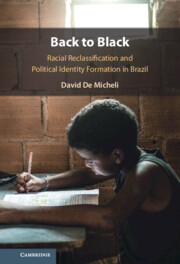Book contents
- Back to Black
- Back to Black
- Copyright page
- Epigraph
- Contents
- Figures
- Tables
- Acknowledgments
- 1 Introduction
- 2 The Puzzle of Racial Reclassification
- 3 Theory
- 4 Education as a Mechanism of Exposure
- 5 Education and Reclassification
- 6 Affirmative Action and Reclassification
- 7 Implications for National Politics
- 8 Conclusion
- References
- Index
- References
References
Published online by Cambridge University Press: 14 November 2024
- Back to Black
- Back to Black
- Copyright page
- Epigraph
- Contents
- Figures
- Tables
- Acknowledgments
- 1 Introduction
- 2 The Puzzle of Racial Reclassification
- 3 Theory
- 4 Education as a Mechanism of Exposure
- 5 Education and Reclassification
- 6 Affirmative Action and Reclassification
- 7 Implications for National Politics
- 8 Conclusion
- References
- Index
- References
- Type
- Chapter
- Information
- Back to BlackRacial Reclassification and Political Identity Formation in Brazil, pp. 265 - 290Publisher: Cambridge University PressPrint publication year: 2024

